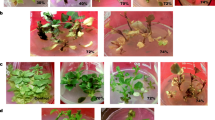Abstract
The present study deals with the selection of Phytophthora tolerant lines of Citrus jambhiri and their regeneration. Cotyledon derived calli were cultured on selective MS medium supplemented with 5–100 % of culture filtrate (CF), to estimate the critical concentration of the selective agent. The survived calli under stress were subcultured for mass propagation for 20 days on callus multiplication medium (2,4-D 2 mg/L + BA 0.75 mg/L) without culture filtrate. After multiplication, these calli were further exposed to other cycles of selection, which contained the same and the 3 steps higher concentrations of the selective agent (CF) and this procedure was repeated several times until the selection regime completed. The selected tolerant calli were transferred to regeneration medium (MS medium supplemented with 3 mg/L of BA and same concentration of culture filtrate on which the calli were selected). Regenerated shoots were transferred to rooting medium (½ strength MS medium supplemented with 0.5 mg/L of NAA). Under in vivo conditions about 81 % of the selected regenerates exhibited resistance to Phytophthora parasitica, whereas none of the control plants showed resistance.




Similar content being viewed by others
Abbreviations
- 2,4-D:
-
2,4-dicholorophenoxy acetic acid
- BA:
-
3-benzyl amino purine
- NAA:
-
Naphthalene acetic acid
- ME:
-
Malt extract
- CF:
-
Culture filtrate
- PSA:
-
Pea sucrose agar medium
- MS:
-
Murashige and Skoog’s medium
References
Arcioni S, Pezzotti M, Damiani F (1987) In vitro selection of alfalfa plants resistant to Fusarium oxysporum f.sp. medicaginis. Theor Appl Genet 74:700–705
Chawla HS, Wenzel G (1987a) In vitro selection of barley and wheat for resistance against Helminthosporium sativum. Theor Appl Genet 74:841–845
Chawla HS, Wenzel G (1987b) In vitro selection for fusaric acid resistant barley plants. Plant Breeding 99:159–163
EL-Kazzaz AA, Malepszy S (1994) Selection of resistant Cucumis sativus regenerated plants to Fusarium oxysporum via tissue culture. Proc. of the 1st Egyptian—Italian Sympos. on Biotechnol., Assiut, Egypt. Pp. 121–130
EL-Kazzaz AA, Abdel-Kader MM (1998) In vitro selection of tomato callus culture and regenerated plants on culture filtrate of Fusarium oxysporum f.sp. lycopersici. Egypt J Phytopathol 26:37–50
El-Kazazz AA, El-Mougy NS (2001) Inheritance of disease resistance in cucumber plants to root-rot caused by Fusarium solani using tissue culture techniques. Egypt J Phytopathol 29:57–68
El-Kazzaz AA, Ashour AMA (2004) Genetically resistant cucumber plants to wilt pathogen via tissue cultures. Egypt J Phytopathol 32:1–10
El-Kazzaz AA, El-Mougy MS (2007) Watermelon resistance to fusarium wilt via tissue culture technique. Arch Phytopathol Plant Protec 1:1–8
El-Kazzaz AA, Abdel-Kader MM, Hussein MH, Hussein HA (1999) Molecular markers for somaclonal variants of faba beans resistant to root-rot (Fusarium solani). Arab J Biotechnol 2:167–180
Hammond-Kosack KE, Jones JDG (1997) Plant disease resistance genes. Annu Rev Plant Physiol 48:575–607
Jayasankar S, Litz RE (1998) Characterization of embryogenic mango cultures selected for resistance to Collectotrichum gloeosporioides culture filtrate and phytotoxins. Theo appl Genet 96:823–831
Jayasankar S, Zhijian L, Gray DJ (2000) In vitro selection of Vitis vinifera ‘chardonnay’ with Elsinoe ampelina culture filtrate is accompanied by fungal resistance and enhanced secretion of chitinase. Planta 211:200–208
Kumar JV, Kumari BDR, Sujata G, Castano E (2008) Production of plants resistant to Alternaria carthami via organogenesis and somatic embryogenesis of safflower cv. NARI-6 treated fungal culture filtrates. Plant Cell Tiss Org Cult 93:85–96
Quaglia M, Zazzerini A (2007) In vitro screening for sunflower (Helianthus annus L.) resistant calli to Diaparthe helianthi fungal culture filtrate. Europ J Plant Pathol 118:393–400
Rodriguez NV, Kowalski B, Rodriguez LG, Caraballoso IB, Suarez MA, Perez PO (2007) In vitro and ex vitro selection of potato plantlets for resistance to early blight. J Phytopathol 155:582–586
Salzman RA, Tikhonova I, Bordelon BP, Hasegawa PM, Bressan RA (1998) Coordiante accumulation of antifungal proteins and hexoses constitutes a developmentally controlled defense response during fruit ripening in grape. Plant Physiol 117:465–472
Savita, Vijay, Virk GS, Nagpal A (2010) Effect of explant type and different plant growth regulators on callus induction and plantlet regeneration in Citrus jambhiri Lush. Env We-An Intern J Sci Tech 5:97–106
Acknowledgement
We are thankful to Council of Scientific and Industrial Research (CSIR) New Delhi, Pusa for providing us the financial assistance to complete the experimental work.
Author information
Authors and Affiliations
Corresponding author
Rights and permissions
About this article
Cite this article
Savita, Virk, G.S. & Nagpal, A. In vitro selection of calli of Citrus jambhiri Lush. for tolerance to culture filtrate of Phytophthora parasitica and their regeneration. Physiol Mol Biol Plants 17, 41–47 (2011). https://doi.org/10.1007/s12298-010-0046-2
Published:
Issue Date:
DOI: https://doi.org/10.1007/s12298-010-0046-2




